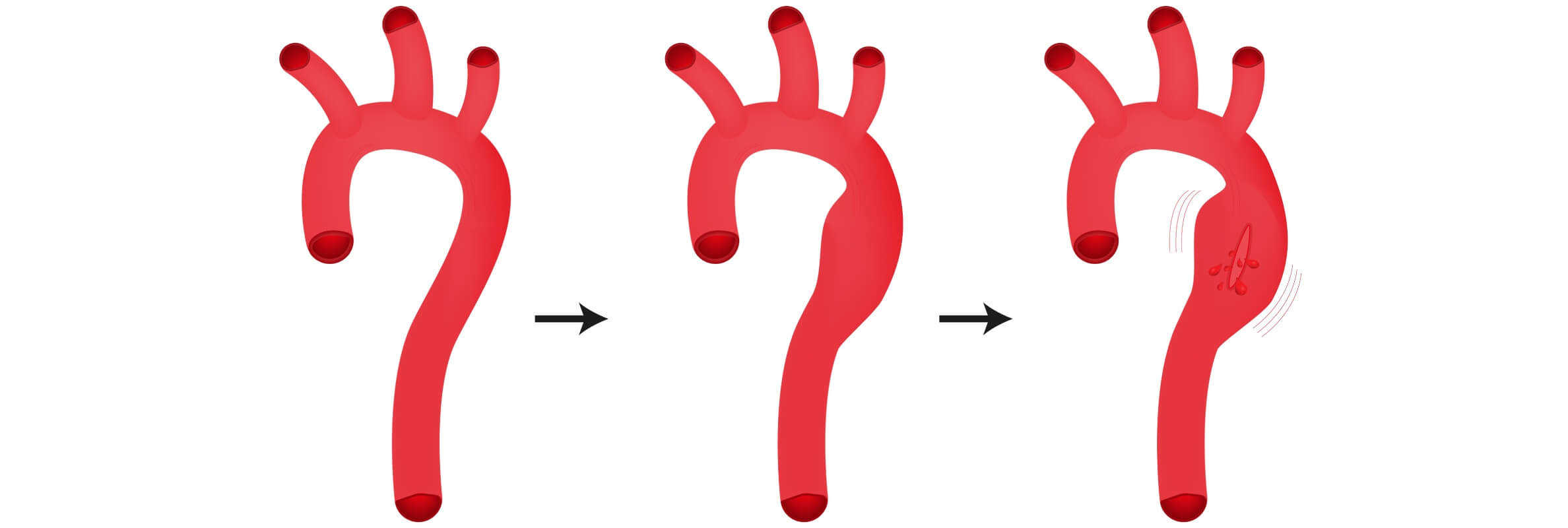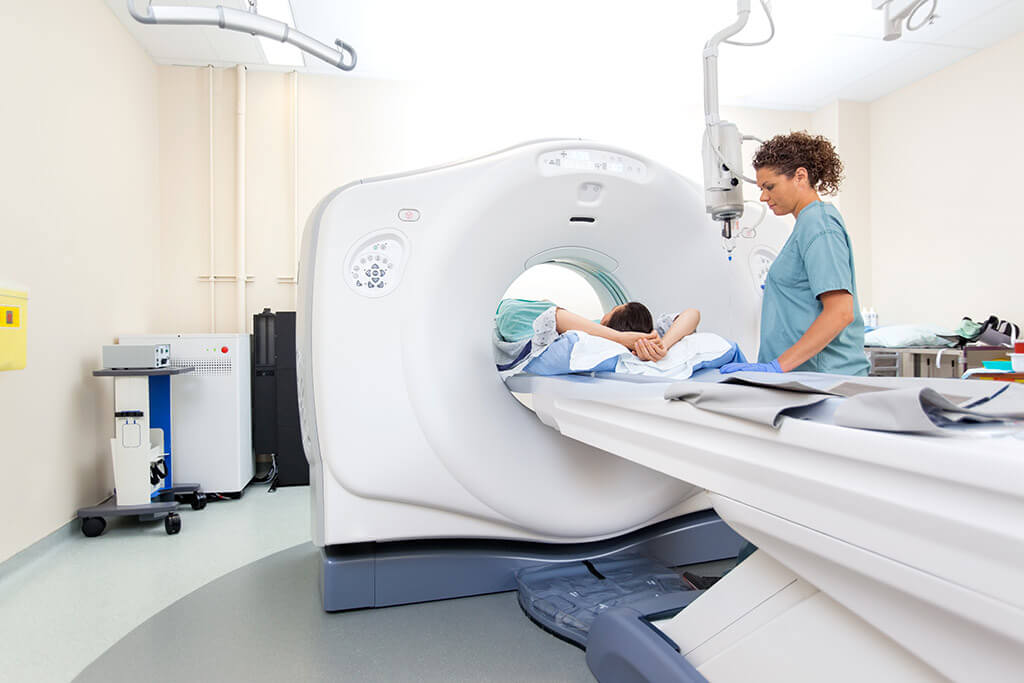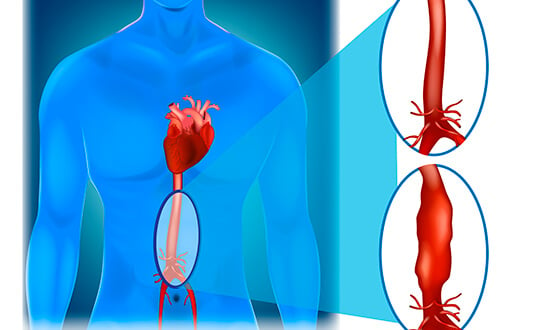Thoracic aortic aneurysm is the expansion of the corresponding blood vessel that is two or more times larger than its normal diameter. It can look like a uniform expansion or a baggy protrusion. Let's talk about what is a thoracic aortic aneurysm.
Content
- Etiology
- Thoracic aortic aneurysm types
- Symptoms of Thoracic aortic aneurysm
- Thoracic aortic aneurysm diagnosis
- Thoracic aortic aneurysm treatment
- Hospitals and cost of treatment
- Arrangement of treatment in Germany
Etiology
Thoracic aortic aneurysm can be of congenital or acquired origin. Causes of congenital thoracic aortic aneurysm are:
- Heart defects
- Diffuse connective tissue diseases
However, most often thoracic aortic aneurysm is acquired. It can appear as a result of the following causes:
- Atherosclerosis
- Syphilis or other infections
- Medical procedures and surgeries
- Nonspecific inflammation of the aorta
- Fungal infection
- Infection of the aortic prosthesis
- Hormonal changes
The risk of this illness increases:
- During pregnancy
- In elderly people
- In males
Thoracic aortic aneurysm types
The aorta consists of two main parts - the thoracic and the abdominal. The thoracic part comes out of the left heart ventricle, ascends a little bit, bends around the arch and descends down. This part ends at the level of the diaphragm, where it passes into the abdominal aorta.
The thoracic part is divided into several sections. Thoracic aortic aneurysm classification is made in accordance with their location in one of the aortic sections. There are such types of pathology as: aortic root aneurysm (aneurysm of the heart aorta or of the Valsalva sinuses), ascending thoracic aortic aneurysm, descending thoracic aortic aneurysm or aortic arch aneurysm.
Symptoms of Thoracic aortic aneurysm
Symptoms of thoracic aortic aneurysm are absent in 75% cases. As a rule, pathology can be detected accidentally, during an x-ray or CT.
Symptoms of thoracic aortic aneurysm can manifest themselves in 25% of cases as such:
- Pain behind the sternum (a possible symptom of the ascending thoracic aortic aneurysm)
- Edema of the upper limbs, neck and head if the superior vena cava is compressed
- In case of concomitant damage to the aortic valve - tachycardia, dizziness, fatigue
- Pain between the shoulder blades in case of aortic arch aneurysm or of descending thoracic aortic aneurysm
- Difficulty in swallowing which relates to the compression of the esophagus
- Drooling, rare pulse are signs of the vagus nerve compression
- Shortness of breath says about compression of the trachea
- Symptoms of thoracic aortic aneurysm appear from the central nervous system due to insufficient blood supply to the brain if branches of aortic arch are compressed by the aneurysm
Thoracic aortic aneurysm diagnosis
Thoracic aortic aneurysm diagnosis starts with the examination and clinical check. Sometimes they determine asymmetry of peripheral arteries pulsation. While auscultation (listening) with an auscultoscope, systolic murmur over the aorta is observed in 70% of patients. Auscultation of the aortic valve is obligatory during examination. Insufficiency of the aortic valve may develop against the background of an ascending thoracic aortic aneurysm. In this case, diastolic noise is heard. Nonetheless, thoracic aortic aneurysm as well as abdominal aortic aneurysm cannot be clinically proven. The basis of diagnosis and the only possible method of confirming the diagnosis are instrumental studies.
About 50% of cases of thoracic aortic aneurysms are detected when performing routine radiography survey. The most accurate method is computed tomography with contrast enhancement. The entire thoracic and abdominal aorta is scanned. Because the probability of finding another one or even more expansion sites is about 25% in case of thoracic aortic aneurysm.
CT allows you to assess the extent of the aneurysm, its precise location and the diameter of the vessel. The condition of the aneurysm is also assessed including the stratification, presence of thrombi, exfoliated areas of the artery intima. During the study, the patency of the aortic branches is determined, as well as the degree of other organs involvement into the pathological process.
When planning surgery, doctors use angiography to assist them. This is an x-ray study, suggesting the introduction of contrast material into the vessels.
Sometimes MRI is used as an additional study. This method also has certain advantages. Thanks to MRI, it is possible to identify fluid clusters, thrombus, hematoma, and slow blood flow. MRI allows you to get information about the function of the heart, the structure of the valves, the patency of the coronary arteries.
Thoracic aortic aneurysm treatment
Surgery is the only possible treatment here. Thoracic aortic aneurysm is a cause for much concern and can lead to death. That’s why the affected vessel section is removed and replaced with an artificial prosthesis. Sometimes it is possible to conduct an endoscopic surgery (minimally invasive method). Other cases require an open surgery.
What will happen if there will be no treatment? In such a case a rupture of thoracic aortic aneurysm can happen. 94% of patients die because of massive blood loss. During the research patients with aneurysm were observed for a period of 30 years and the risk of its rupture was about 74%. Besides, dissecting thoracic aneurysm ruptured much more often - in 95% of the observed patients. Aneurysm rupture happened in 51% of patients within 30 years in case of undissected aneurysms. Average time between the diagnosis establishment and rupture of the thoracic aortic aneurysm is 2 years.
Five-year-survival rate of the patients is:
- average – 13%
- in case of not dissecting aneurysm – 19%
- in case of a dissecting aneurysm – 7%
Patients die not only because of the aneurysm rupture, but as a result of cardio-vascular diseases complications. Judging from the statistics, it is clear that even if this pathology doesn’t show any symptoms and doesn’t bother your life, it must be treated as soon as possible.
Hospitals and cost of treatment
In Germany, all types of thoracic aortic aneurysms are treated successfully. We considered the treatment success rates, availability of the modern equipment, the use of minimally invasive methods of treatment, etc. and identified the leading hospitals for the treatment of thoracic aortic aneurysm:
- University Hospital of Ludwig-Maximilian University of Munich, Department of Vascular Surgery
- Charite University Hospital Berlin, Department of General, Abdominal and Vascular Surgery
- University Hospital Carl Gustav Carus Dresden, Department of Abdominal, Thoracic and Vascular Surgery
- University Hospital Frankfurt-am-Main, Department of Vascular and Endovascular Surgery
- University Hospital Heidelberg, Department of Vascular and Endovascular Surgery
The average cost of the main types of treatment is as follows:
- Examination for suspected thoracic aortic aneurysm – €2,740
- Open aortic replacement in thoracic aortic aneurysm – €46,340
- Endovascular aortic replacement in thoracic aortic aneurysm – €47,760
- Rehabilitation after completion of the main course of treatment – €1,030 per day
Arrangement of treatment in Germany
If you need surgical treatment of the thoracic aortic aneurysm, you can contact one of the clinics in Germany with our help.
Booking Health is a leader in the field of medical tourism. We arrange treatment in Germany and other countries around the world.
By using our services, you get a number of advantages:
- Reducing the waiting time for treatment - you will have time to get surgery before the aneurysm ruptures.
- Saving up to 70% on medical services because we have direct contracts with all clinics and you do not have to pay insurance for foreign patients.
- A full package of services, ranging from document processing, ending with your transfer to the clinic and back to the airport after the completion of treatment.
To use the services of Booking Health, leave a request on our website. We will select a clinic for you and call you back as soon as possible.
Choose treatment abroad and you will for sure get the best results!
Authors:
The article was edited by medical experts, board certified doctors Dr. Vadim Zhiliuk, Dr. Nadezhda Ivanisova. For the treatment of the conditions referred to in the article, you must consult a doctor; the information in the article is not intended for self-medication!
Sources:
ECR - European Cardiology Review
JAHA - Journal of the American Heart Association
Read:
Why Booking Health - questions and answers
How to make right decision when choosing the clinic and specialist
7 reasons to trust to the rating of clinics on the Booking Health portal
Don't know where to start?
Contact Booking Health







